The Effect of Compost-Bedded Pack Barns on Claw Health and Lameness in Dairy Herds in Southern Germany
Simple Summary
Abstract
1. Introduction
2. Materials and Methods
2.1. Selection of Farms
2.2. Farm Visits
2.3. Recording of Barn Conditions: Construction, Housing Conditions, and Management
2.4. Lameness Scoring and Recording of Claw Lesions
2.5. Evaluation of Compost Quality
2.6. Calculation of the Cow Claw and Farm Claw Scores
2.7. Statistical Analysis
3. Results
3.1. Barn Conditions and Compost Quality
3.2. Lameness Scoring
3.3. Claw Health
3.3.1. Claw Diseases and Claw Shape
3.3.2. Cow and Farm Claw Scores
4. Discussion
5. Conclusions
Supplementary Materials
Author Contributions
Funding
Institutional Review Board Statement
Informed Consent Statement
Data Availability Statement
Published Materials
Acknowledgments
Conflicts of Interest
References
- Esslemont, R.; Kossaibati, M. Incidence of production diseases and other health problems in a group of dairy herds in England. Vet. Rec. 1996, 139, 486–490. [Google Scholar] [CrossRef] [PubMed]
- Frei, C.; Frei, P.P.; Stärk, K.D.; Pfeiffer, D.U.; Kihm, U. The production system and disease incidence in a national random longitudinal study of Swiss dairy herds. Prev. Vet. Med. 1997, 32, 1–21. [Google Scholar] [CrossRef] [PubMed]
- Fourichon, C.; Beaudeau, F.; Bareille, N.; Seegers, H. Incidence of health disorders in dairy farming systems in western France. Livest. Prod. Sci. 2001, 68, 157–170. [Google Scholar] [CrossRef]
- Warnick, L.D.; Janssen, D.; Guard, C.; Groehn, Y.T. The effect of lameness on milk production in dairy cows. J. Dairy Sci. 2001, 84, 1988–1997. [Google Scholar] [CrossRef]
- Melendez, P.; Bartolome, J.; Archbald, L.; Donovan, A. The association between lameness, ovarian cysts and fertility in lactating dairy cows. Theriogenology 2003, 59, 927–937. [Google Scholar] [CrossRef]
- Kulkarni, P.S.; Mourits, M.C.M.; Slob, J.; Veldhuis, A.M.B.; Nielen, M.; Hogeveen, H.; Schaik, G.V.; Steeneveld, W. Dutch dairy farmers’ perspectives on culling reasons and strategies. Prev. Vet. Med. 2023, 218, 105997. [Google Scholar] [CrossRef]
- Whay, H.; Waterman, A.; Webster, A.; O’brien, J. The influence of lesion type on the duration of hyperalgesia associated with hindlimb lameness in dairy cattle. Vet. J. 1998, 156, 23–29. [Google Scholar] [CrossRef]
- Gomez, A.; Cook, N. Time budgets of lactating dairy cattle in commercial freestall herds. J. Dairy Sci. 2010, 93, 5772–5781. [Google Scholar] [CrossRef]
- Thomsen, P.T.; Shearer, J.K.; Houe, H. Prevalence of lameness in dairy cows: A literature review. Vet. J. 2023, 295, 105975. [Google Scholar] [CrossRef]
- PraeRi (2020): Animal Health, Hygiene and Biosecurity in German Dairy Cow Operations—A Prevalence Study (PraeRi). Final Report. 30 June 2020. Available online: https://ibei.tiho-hannover.de/praeri/pages/69#_AB (accessed on 23 March 2025).
- Murray, R.; Downham, D.; Clarkson, M.; Faull, W.; Hughes, J.; Manson, F.; Merritt, J.; Russell, W.; Sutherst, J.; Ward, W. Epidemiology of lameness in dairy cattle: Description and analysis of foot lesions. Vet. Rec. 1996, 138, 586–591. [Google Scholar] [CrossRef]
- Kofler, J.; Berger, P. Benchmarking claw health across three dairy cow breeds in 508 dairy farms using numerical claw health indicators. Vet. J. 2024, 308, 106242. [Google Scholar] [CrossRef] [PubMed]
- Blowey, R. Factors associated with lameness in dairy cattle. Practice 2005, 27, 154–162. [Google Scholar] [CrossRef]
- Mülling, C.K.; Green, L.; Barker, Z.; Scaife, J.; Amory, J.; Speijers, M. Risk factors associated with foot lameness in dairy cattle and a suggested approach for lameness reduction. In Proceedings of the World Buiatrics Congress, Nice, France, 15–19 October 2006. [Google Scholar]
- Janni, K.A.; Endres, M.I.; Reneau, J.K.; Schoper, W.W. Compost dairy barn layout and management recommendations. Appl. Eng. Agric. 2007, 23, 97–102. [Google Scholar] [CrossRef]
- Barberg, A.E.; Endres, M.I.; Salfer, J.A.; Reneau, J.K. Performance and welfare of dairy cows in an alternative housing system in Minnesota. J. Dairy Sci. 2007, 90, 1575–1583. [Google Scholar] [CrossRef]
- Black, R.A.; Taraba, J.L.; Day, G.B.; Damasceno, F.A.; Bewley, J.M. Compost bedded pack dairy barn management, performance, and producer satisfaction. J. Dairy Sci. 2013, 96, 8060–8074. [Google Scholar] [CrossRef]
- Leso, L.; Pellegrini, P.; Barbari, M. Effect of two housing systems on performance and longevity of dairy cows in Northern Italy. Agron. Res. 2019, 17, 574–581. [Google Scholar] [CrossRef]
- Eckelkamp, E.; Gravatte, C.; Coombs, C.; Bewley, J. Case study: Characterization of lying behavior in dairy cows transitioning from a freestall barn with pasture access to a compost bedded pack barn without pasture access. Prof. Anim. Sci. 2014, 30, 109–113. [Google Scholar] [CrossRef]
- Fernandez, A.; Mainau, E.; Manteca, X.; Siurana, A.; Castillejos, L. Impacts of compost cedded pack barns on the welfare and comfort of dairy cows. Animals 2020, 10, 431. [Google Scholar] [CrossRef]
- Leso, L.; Barbari, M.; Lopes, M.A.; Damasceno, F.A.; Galama, P.; Taraba, J.L.; Kuipers, A. Invited review: Compost-bedded pack barns for dairy cows. J. Dairy Sci. 2020, 103, 1072–1099. [Google Scholar] [CrossRef]
- Lobeck, K.M.; Endres, M.I.; Shane, E.M.; Godden, S.M.; Fetrow, J. Animal welfare in cross-ventilated, compost-bedded pack, and naturally ventilated dairy barns in the upper Midwest. J. Dairy Sci. 2011, 94, 5469–5479. [Google Scholar] [CrossRef]
- Costa, J.H.C.; Burnett, T.A.; von Keyserlingk, M.A.G.; Hotzel, M.J. Prevalence of lameness and leg lesions of lactating dairy cows housed in southern Brazil: Effects of housing systems. J. Dairy Sci. 2018, 101, 2395–2405. [Google Scholar] [CrossRef] [PubMed]
- Burgstaller, J.; Raith, J.; Kuchling, S.; Mandl, V.; Hund, A.; Kofler, J. Claw health and prevalence of lameness in cows from compost bedded and cubicle freestall dairy barns in Austria. Vet. J. 2016, 216, 81–86. [Google Scholar] [CrossRef] [PubMed]
- Sprecher, D.J.; Hostetler, D.E.; Kaneene, J.B. A lameness scoring system that uses posture and gait to predict dairy cattle reproductive performance. Theriogenology 1997, 47, 1179–1187. [Google Scholar] [CrossRef] [PubMed]
- Egger-Danner, C.; Nielsen, P.; Fiedler, A.; Müller, K.; Fjeldaas, T.; Döpfer, D.; Daniel, V.; Bergsten, C.; Cramer, G.; Christen, A.-M.; et al. ICAR Claw Health Atlas. Available online: https://old.icar.org/ICAR_Claw_Health_Atlas.pdf (accessed on 23 March 2025).
- Kofler, J.; Fiedler, A.; Charfeddine, N.; Capion, N.; Fjeldaas, T.; Cramer, G.; Bell, N.J.; Müller, K.E.; Christen, A.-M.; Thomas, G.; et al. ICAR Claw Health Atlas-Appendix 1: Digital Dermatitis Stages (M-Stages). Available online: https://www.icar.org/Documents/ICAR-Claw-Health-Atlas-Appendix-1-DD-stages-M-stages.pdf (accessed on 23 March 2025).
- Kofler, J.; Fiedler, A.; Charfeddine, N.; Capion, N.; Fjeldaas, T.; Cramer, G.; Bell, N.J.; Müller, K.E.; Christen, A.-M.; Thomas, G.; et al. ICAR Claw Health Atlas—Appendix 2: Digital Dermatitis-associated Claw Horn Lesions. Available online: https://www.icar.org/Documents/ICAR-Claw-Health-Atlas-Appendix-2-DD-associated-Claw-Horn-Lesions.pdf (accessed on 23 March 2025).
- Eckelkamp, E.A.; Taraba, J.L.; Akers, K.A.; Harmon, R.J.; Bewley, J.M. Sand bedded freestall and compost bedded pack effects on cow hygiene, locomotion, and mastitis indicators. Livest. Sci. 2016, 190, 48–57. [Google Scholar] [CrossRef]
- Kofler, J.; Hoefler, M.; Hartinger, T.; Castillo-Lopez, E.; Huber, J.; Tichy, A.; Reisinger, N.; Zebeli, Q. Effects of high concentrate-induced subacute ruminal acidosis severity on claw health in first-lactation Holstein cows. Animals 2023, 13, 1418. [Google Scholar] [CrossRef]
- Kofler, J.; Hangl, A.; Pesenhofer, R.; Landl, G. Evaluation of claw health in heifers in seven dairy farms using a digital claw trimming protocol and claw data analysis system. Berl. Munch. Tierarztl. Wochenschr. 2011, 124, 272–281. [Google Scholar] [CrossRef]
- Greenough, P.; Vermunt, J. Evaluation of subclinical laminitis in a dairy herd and observations on associated nutritional and management factors. Vet. Rec. 1991, 128, 11–17. [Google Scholar] [CrossRef]
- Leach, K.; Logue, D.; Randall, J.; Kempson, S. Claw lesions in dairy cattle: Methods for assessment of sole and white line lesions. Vet. J. 1998, 155, 91–102. [Google Scholar] [CrossRef]
- Huber, J.; Stanek, C.; Troxler, J. Effects of regular claw trimming in different housing systems. In Proceedings of the 13th International Symposium and 5th Conference on Lameness in Ruminants, Maribor, Slovenija, 11–15 February 2004. [Google Scholar]
- Destatis, Statistisches Bundesamt. Flächengröße des Waldes nach Bundesländern. Available online: https://www.destatis.de/DE/Themen/Branchen-Unternehmen/Landwirtschaft-Forstwirtschaft-Fischerei/Wald-Holz/Tabellen/waldflaeche-bundeslaender.html (accessed on 23 March 2025).
- Armbrecht, L.; Lambertz, C.; Albers, D.; Gauly, M. Does access to pasture affect claw condition and health in dairy cows? Vet. Rec. 2018, 182, 79. [Google Scholar] [CrossRef]
- Haufe, H.C.; Gygax, L.; Wechsler, B.; Stauffacher, M.; Friedli, K. Influence of floor surface and access to pasture on claw health in dairy cows kept in cubicle housing systems. Prev. Vet. Med. 2012, 105, 85–92. [Google Scholar] [CrossRef]
- Rynk, R.; Van de Kamp, M.; Willson, G.B.; Singley, M.E.; Richard, T.L.; Kolega, J.J.; Gouin, F.R.; Laliberty, L.; Kay, D.; Murphy, D. On-Farm Composting Handbook (NRAES 54); NRAES (Northeast Regional Agricultural Engineering Service): Ithaca, NY, USA, 1992; Available online: https://hdl.handle.net/1813/67142 (accessed on 23 March 2025).
- Leso, L.; Uberti, M.; Morshed, W.; Barbari, M. A survey of Italian compost dairy barns. J. Agric. Eng. 2013, 44, 203–207. [Google Scholar] [CrossRef][Green Version]
- The Dairyland Initiative, School of Veterinary Medicine, University of Wisconsin-Madison. Bedded Packs. Available online: https://thedairylandinitiative.vetmed.wisc.edu/home/housing-module/adult-cow-housing/bedded-pack/ (accessed on 19 April 2025).
- Bewley, J.; Taraba, J.L. Cow Focused Solutions. Ten Essential Rules for Building a Compost Bedded Pack Barn. Available online: https://www.cowfocused.com/papers/2018/5/11/ten-essential-rules-for-building-a-compost-bedded-pack-barn (accessed on 19 April 2025).
- Damasceno, F.A.; Day, G.B.; Taraba, J.L.; Oliveira, C.E.A.; Andrade, R.R.; Frigeri, K.D.M.; Vieira, F.M.C.; Barbari, M.; Bambi, G. Compost Dairy Barn Layout and Management Recommendations in Kentucky: A Descriptive Study. Animals 2022, 12, 3324. [Google Scholar] [CrossRef] [PubMed]
- Singh, S.; Ward, W.; Lautenbach, K.; Murray, R. Behaviour of lame and normal dairy cows in cubicles and in a straw yard. Vet. Rec. 1993, 133, 204–208. [Google Scholar] [CrossRef] [PubMed]
- Galindo, F.; Broom, D. The relationships between social behaviour of dairy cows and the occurrence of lameness in three herds. Res. Vet. Sci. 2000, 69, 75–79. [Google Scholar] [CrossRef]
- Bicalho, R.C.; Oikonomou, G. Control and prevention of lameness associated with claw lesions in dairy cows. Livest. Sci. 2013, 156, 96–105. [Google Scholar] [CrossRef]
- Telezhenko, E.; Magnusson, M.; Bergsten, C. Gait of dairy cows on floors with different slipperiness. J. Dairy Sci. 2017, 100, 6494–6503. [Google Scholar] [CrossRef]
- Cook, N.B.; Mentink, R.L.; Bennett, T.B.; Burgi, K. The Effect of Heat Stress and Lameness on Time Budgets of Lactating Dairy Cows. J. Dairy Sci. 2007, 90, 1674–1682. [Google Scholar] [CrossRef]
- Andrade, E.T.; Tinoco, I.F.F.; Damasceno, F.A.; Valente, D.A.; Oliveira, C.E.A.; Oliveira, V.C.; Rossi, G.; Barbari, M. Analysis of environmental conditions in two different Compost Bedded Pack Barn systems for dairy cattle. Agron. Res. 2023, 21, 1049–1057. [Google Scholar] [CrossRef]
- Chen, J.M.; Stull, C.L.; Ledgerwood, D.N.; Tucker, C.B. Muddy conditions reduce hygiene and lying time in dairy cattle and increase time spent on concrete. J. Dairy Sci. 2017, 100, 2090–2103. [Google Scholar] [CrossRef]
- Schütz, K.; Cave, V.; Cox, N.; Huddart, F.; Tucker, C. Effects of 3 surface types on dairy cattle behavior, preference, and hygiene. J. Dairy Sci. 2019, 102, 1530–1541. [Google Scholar] [CrossRef]
- Tucker, C.B.; Weary, D.M.; Fraser, D. Effects of three types of free-stall surfaces on preferences and stall usage by dairy cows. J. Dairy Sci. 2003, 86, 521–529. [Google Scholar] [CrossRef] [PubMed]
- Fregonesi, J.; Veira, D.; Von Keyserlingk, M.; Weary, D. Effects of bedding quality on lying behavior of dairy cows. J. Dairy Sci. 2007, 90, 5468–5472. [Google Scholar] [CrossRef] [PubMed]
- Bergsten, C.; Pettersson, B. The cleanliness of cows tied in stalls and the health of their hooves as influenced by the use of electric trainers. Prev. Vet. Med. 1992, 13, 229–238. [Google Scholar] [CrossRef]
- Jury, A.; Syring, C.; Becker, J.; Locher, I.; Strauss, G.; Ruiters, M.; Steiner, A. Prevalence of claw disorders in swiss cattle farms. Schweiz. Arch. Tierheilkd. 2021, 164, 779–790. [Google Scholar] [CrossRef]
- Laven, R. The environment and digital dermatitis. Cattle Pract. 1999, 7, 349–354. [Google Scholar]
- Oliveira, V.H.S.; Sorensen, J.T.; Thomsen, P.T. Associations between biosecurity practices and bovine digital dermatitis in Danish dairy herds. J. Dairy Sci. 2017, 100, 8398–8408. [Google Scholar] [CrossRef]
- De Jong, E.; Frankena, K.; Orsel, K. Risk factors for digital dermatitis in free-stall-housed, Canadian dairy cattle. Vet. Rec. Open 2021, 8, e19. [Google Scholar] [CrossRef]
- Somers, J.; Frankena, K.; Noordhuizen-Stassen, E.N.; Metz, J. Prevalence of claw disorders in Dutch dairy cows exposed to several floor systems. J. Dairy Sci. 2003, 86, 2082–2093. [Google Scholar] [CrossRef]
- Bell, J.; Crosby-Durrani, H.E.; Blowey, R.W.; Carter, S.D.; Evans, N.J. Survival of bovine digital dermatitis treponemes in conditions relevant to the host and farm environment. Anaerobe 2023, 82, 102766. [Google Scholar] [CrossRef]
- Nagaraja, T.; Narayanan, S.; Stewart, G.; Chengappa, M. Fusobacterium necrophorum infections in animals: Pathogenesis and pathogenic mechanisms. Anaerobe 2005, 11, 239–246. [Google Scholar] [CrossRef]
- Kontturi, M.; Junni, R.; Simojoki, H.; Malinen, E.; Seuna, E.; Klitgaard, K.; Kujala-Wirth, M.; Soveri, T.; Pelkonen, S. Bacterial species associated with interdigital phlegmon outbreaks in Finnish dairy herds. BMC Vet. Res. 2019, 15, 44. [Google Scholar] [CrossRef] [PubMed]
- Cook, N.B.; Nordlund, K.V. The influence of the environment on dairy cow behavior, claw health and herd lameness dynamics. Vet. J. 2009, 179, 360–369. [Google Scholar] [CrossRef] [PubMed]
- Oehme, B.; Geiger, S.; Grund, S.; Hainke, K.; Munzel, J.; Mülling, C. Effect of different flooring types on pressure distribution under the bovine claw–an ex vivo study. BMC Vet. Res. 2018, 14, 259. [Google Scholar] [CrossRef] [PubMed]
- Oehme, B.; Grund, S.; Munzel, J.; Mülling, C. Kinetic effect of different ground conditions on the sole of the claws of standing and walking dairy cows. J. Dairy Sci. 2019, 102, 10119–10128. [Google Scholar] [CrossRef]
- Van der Tol, P.; Metz, J.; Noordhuizen-Stassen, E.; Back, W.; Braam, C.; Weijs, W. The vertical ground reaction force and the pressure distribution on the claws of dairy cows while walking on a flat substrate. J. Dairy Sci. 2003, 86, 2875–2883. [Google Scholar] [CrossRef]
- Bergsten, C.; Telezhenko, E.; Ventorp, M. Influence of soft or hard floors before and after first calving on dairy heifer locomotion, claw and leg health. Animals 2015, 5, 662–686. [Google Scholar] [CrossRef]
- Borderas, T.; Pawluczuk, B.; De Passillé, A.; Rushen, J. Claw hardness of dairy cows: Relationship to water content and claw lesions. J. Dairy Sci. 2004, 87, 2085–2093. [Google Scholar] [CrossRef]
- Kofler, J. Computerised claw trimming database programs as the basis for monitoring hoof health in dairy herds. Vet. J. 2013, 198, 358–361. [Google Scholar] [CrossRef]
- Guhl, P.A.; Bachmann, L.; Steiner, A.; Heppelmann, M. Lameness and claw health of dairy cows in German compost bedded pack barns. In Proceedings of the 32nd World Buiatrics Congress, Cancun, Mexico, 20–24 May 2024. [Google Scholar]
- Guhl, P.A.; Bachmann, L.; Steiner, A.; Heppelmann, M. Claw health and lameness in German compost bedded pack barns. In Proceedings of the 22nd International Symposium and 14th International Conference on Lameness in Ruminants, Venice, Italy, 16–20 September 2024. [Google Scholar]
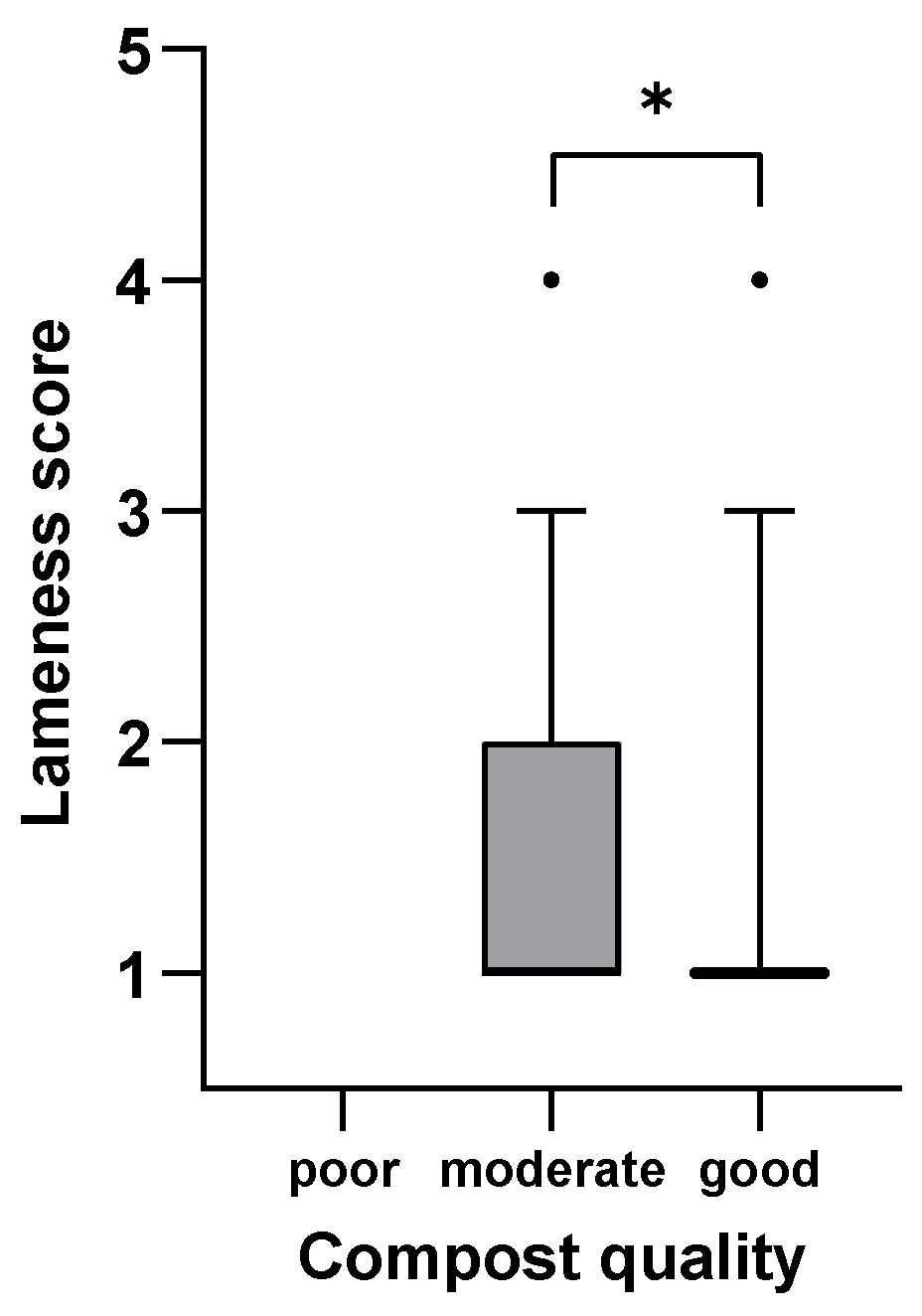
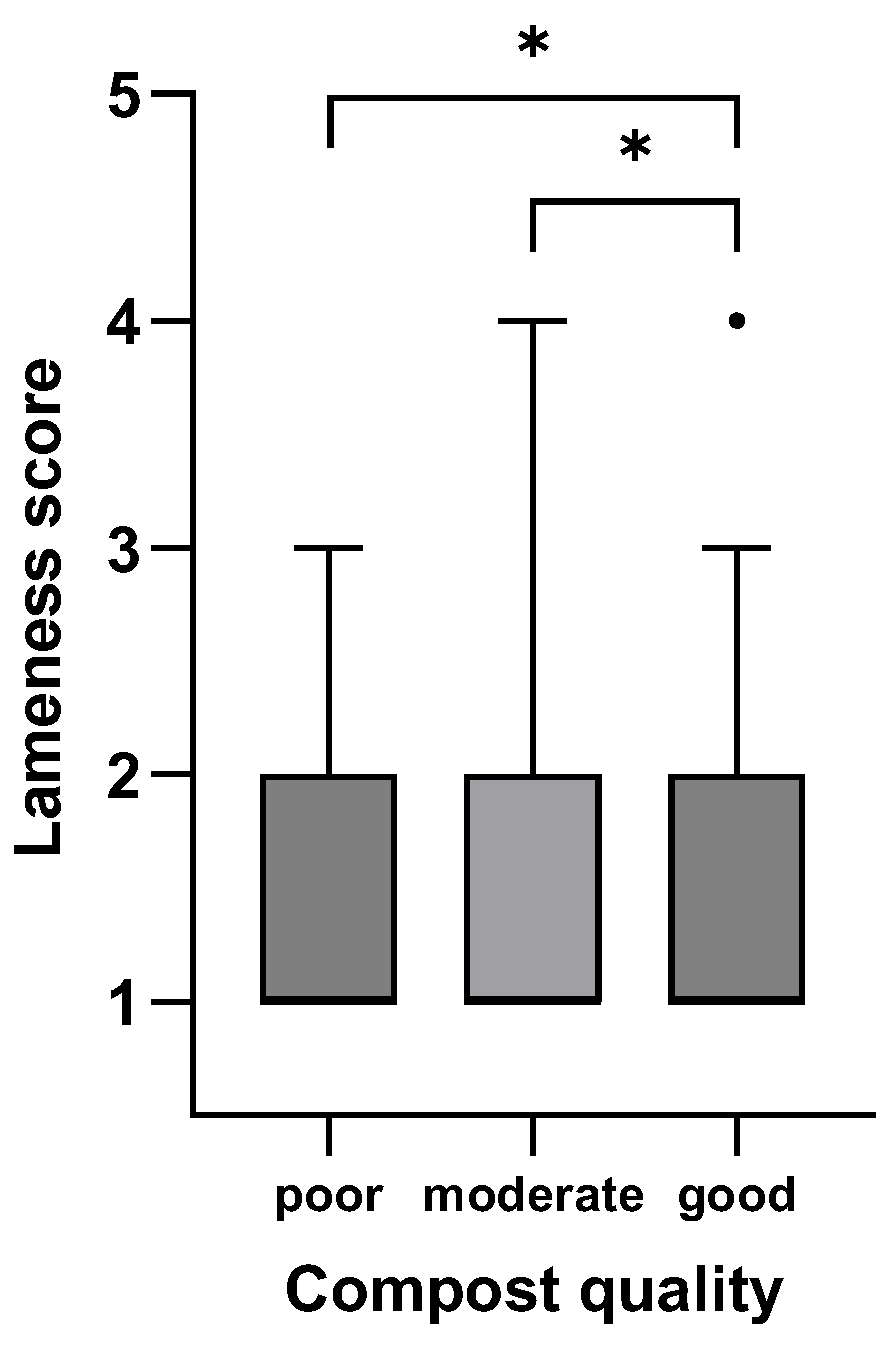
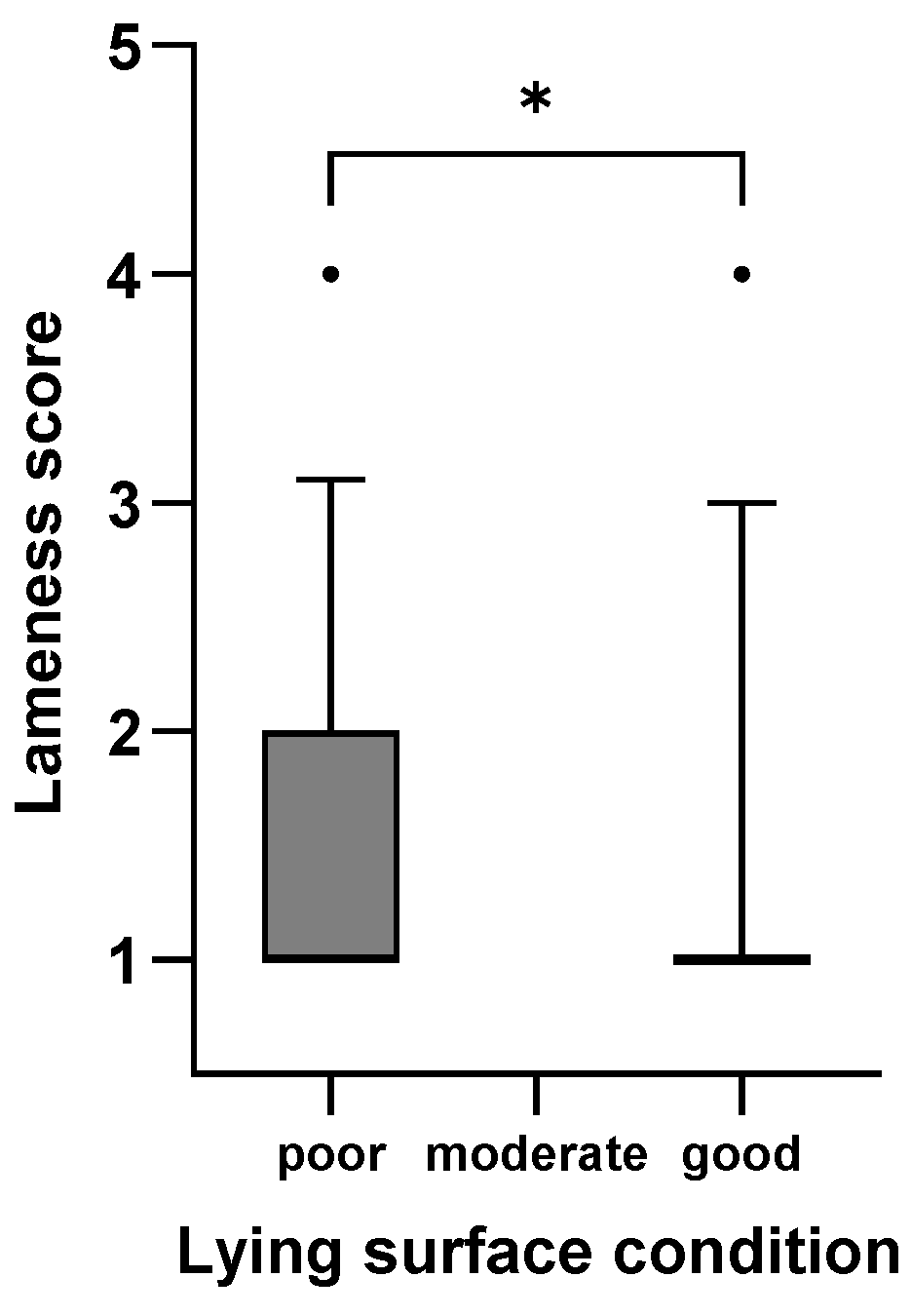
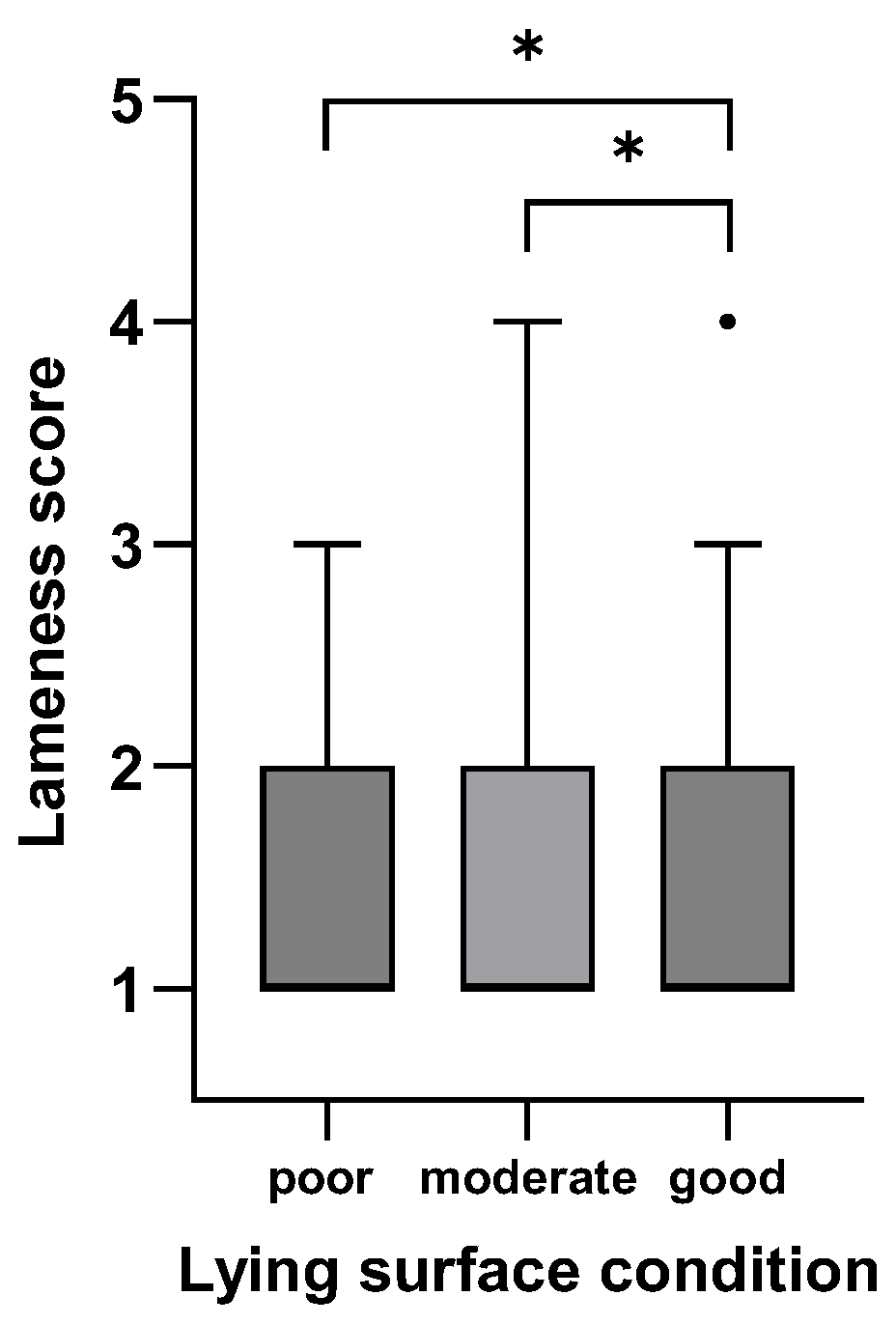
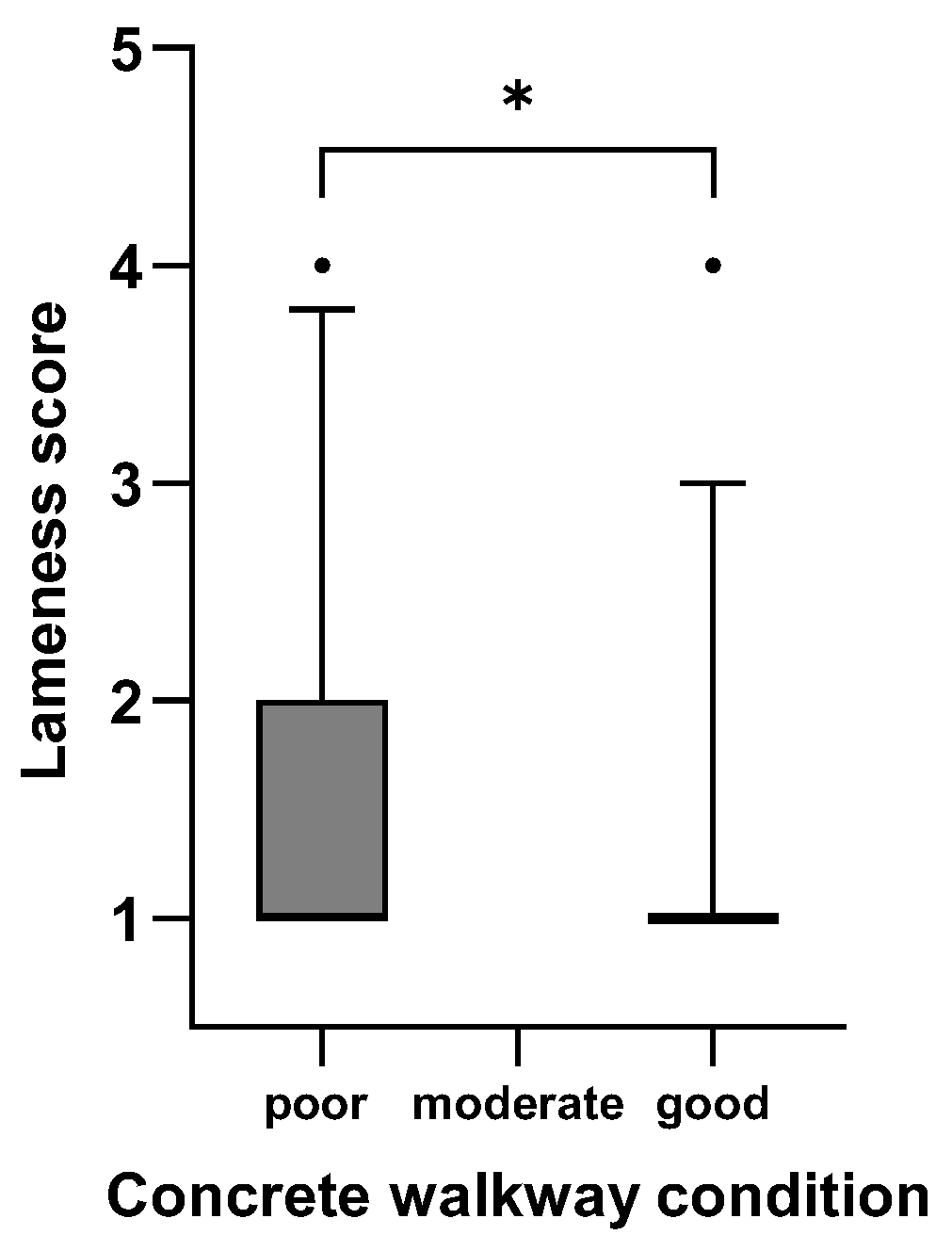
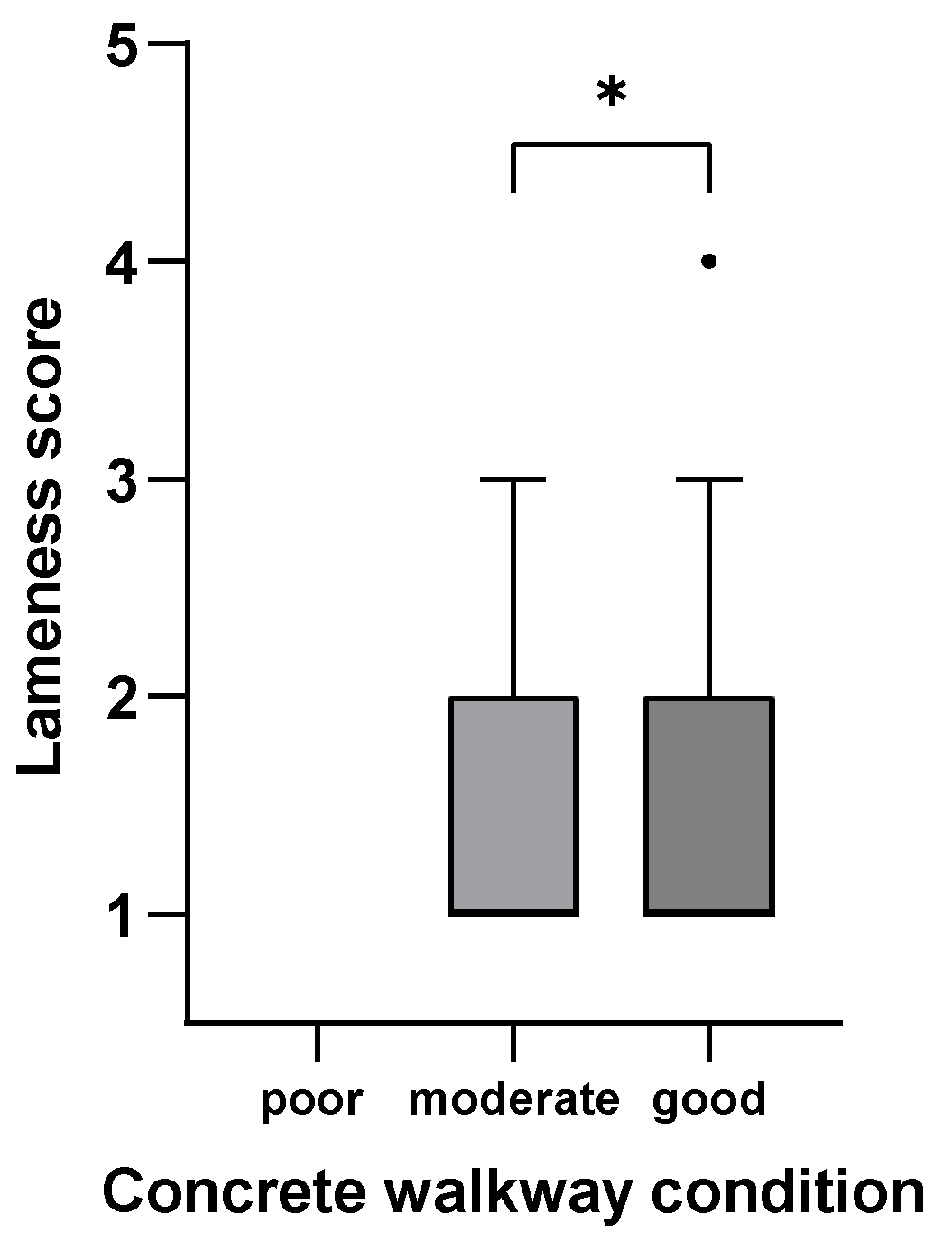
| Group Comparison | Cold Season | Warm Season | |||||
|---|---|---|---|---|---|---|---|
| OR | p-Values | 95% Wald Confidence Interval | OR | p-Values | 95% Wald Confidence Interval | ||
| Compost quality | moderate vs. good | 3.7 | 0.0001 | 1.9–7.3 | 1.8 | 0.0861 | 0.9–3.6 |
| poor vs. good | 0.9 | 0.9037 | 0.4–2.5 | ||||
| Lying surface | moderate vs. good | 1.8 | 0.0861 | 0.9–3.6 | |||
| poor vs. good | 0.8 | 0.6070 | 0.3–1.9 | 0.9 | 0.9037 | 0.4–2.5 | |
| Concrete walkway | moderate vs. good | 1.8 | 0.0861 | 0.9–3.6 | |||
| poor vs. good | 1.2 | 0.5821 | 0.5–3.1 | ||||
| Claw Disorder | Total [%] | Severity Score [%] | Comparison Values [%] | p-Values | |||
|---|---|---|---|---|---|---|---|
| Cow Level | Farm Level | Slight | Moderate | Severe | |||
| HHE | 42.2 | 38.5 ± 26.7 # | 94.5 | 5.1 | 0.4 | 48.0 | 0.3465 |
| DD a | 11.3 | 10.7 ± 12.1 # | n.a. | n.a | n.a | 18.6 | 0.1087 |
| DD b | 11.3 | 14.3 ± 12.0 # | n.a. | n.a. | n.a. | 33.2 | 0.0119 |
| ID | 1.9 | 0 ± 0 * | n.a | n.a | n.a | n.a. | n.a |
| Claw Disorder | Total [%] | Severity Score [%] | Comparison Values [%] | p-Values | |||
|---|---|---|---|---|---|---|---|
| Cow Level | Farm Level | Slight | Moderate | Severe | |||
| WLF | 35.2 | 37.1 ± 19.1 # | 90.3 | 9.4 | 0.3 | 56.8 | 0.0266 |
| SHC | 31.6 | 31.6 ± 10.7 # | 93.6 | 6.4 | 0.0 | n.a. | n.a. |
| SHD | 17.0 | 19.2 ± 16.9 # | 86.5 | 12.9 | 0.6 | n.a. | n.a. |
| DS | 7.3 | 8.0 ± 7.0 # | 59.2 | 34.7 | 6.1 | 18.8 | 0.00332 |
| Ulcers (SU, BU, TU) | 4.5 | 4.7 ± 4.7 # | n.a. | n.a. | n.a. | 13.6 | 0.001 |
| SU | 3.4 | 3.4 ± 3.5 # | 73.9 | 21.7 | 4.4 | n.a. | n.a. |
| IH | 2.5 | 2.2 ± 1.9 # | 84.7 | 5.3 | 0.0 | 5.0 | 0.012 |
| HFA | 1.9 | 0.9 ± 0.9 * | 82.4 | 17.6 | 0.0 | n.a. | n.a. |
| WLA | 1.4 | 0 ± 0 * | 70.0 | 30.0 | 0.0 | n.a. | n.a. |
| SW | 1.1 | 0 ± 0 * | 100.0 | 0.0 | 0.0 | n.a. | n.a. |
| BU | 0.8 | 0 ± 0 * | 80.0 | 0.0 | 20.0 | n.a. | n.a. |
| TU | 0.2 | 0 ± 0 * | 0.0 | 100.0 | 0.0 | n.a. | n.a. |
| TN | 0.2 | 0 ± 0 * | n.a. | n.a. | n.a. | n.a. | n.a. |
| Claw Disorder | Total [%] | |
|---|---|---|
| Cow Level | Farm Level | |
| AC | 14.4 | 16.8 ± 9.3 # |
| CC | 6.4 | 1.3 ± 1.3 * |
| SC | 1.6 | 0.8 ± 0.8 * |
| CD | 1.1 | 0.4 ± 0.4 * |
| TS | 0.8 | 0 ± 0 * |
Disclaimer/Publisher’s Note: The statements, opinions and data contained in all publications are solely those of the individual author(s) and contributor(s) and not of MDPI and/or the editor(s). MDPI and/or the editor(s) disclaim responsibility for any injury to people or property resulting from any ideas, methods, instructions or products referred to in the content. |
© 2025 by the authors. Licensee MDPI, Basel, Switzerland. This article is an open access article distributed under the terms and conditions of the Creative Commons Attribution (CC BY) license (https://creativecommons.org/licenses/by/4.0/).
Share and Cite
Guhl, P.A.; Steiner, A.; Bachmann, L.; Heppelmann, M. The Effect of Compost-Bedded Pack Barns on Claw Health and Lameness in Dairy Herds in Southern Germany. Animals 2025, 15, 1347. https://doi.org/10.3390/ani15091347
Guhl PA, Steiner A, Bachmann L, Heppelmann M. The Effect of Compost-Bedded Pack Barns on Claw Health and Lameness in Dairy Herds in Southern Germany. Animals. 2025; 15(9):1347. https://doi.org/10.3390/ani15091347
Chicago/Turabian StyleGuhl, Phillip Andreas, Adrian Steiner, Lisa Bachmann, and Maike Heppelmann. 2025. "The Effect of Compost-Bedded Pack Barns on Claw Health and Lameness in Dairy Herds in Southern Germany" Animals 15, no. 9: 1347. https://doi.org/10.3390/ani15091347
APA StyleGuhl, P. A., Steiner, A., Bachmann, L., & Heppelmann, M. (2025). The Effect of Compost-Bedded Pack Barns on Claw Health and Lameness in Dairy Herds in Southern Germany. Animals, 15(9), 1347. https://doi.org/10.3390/ani15091347






